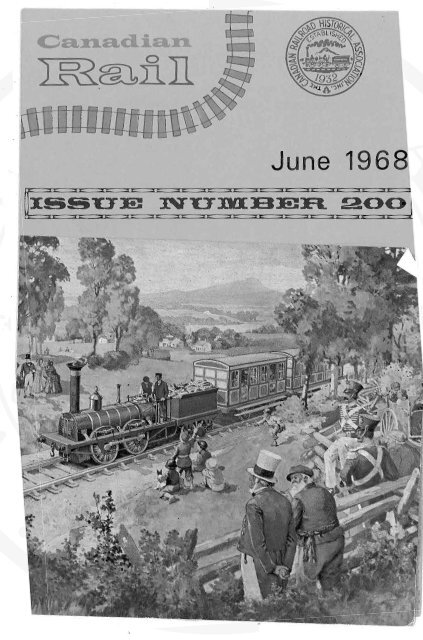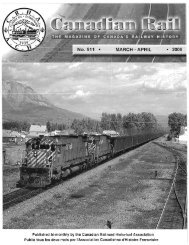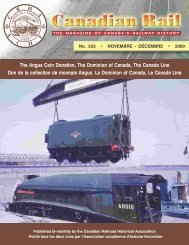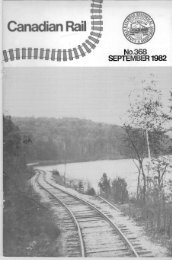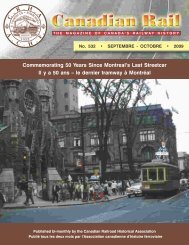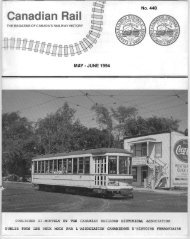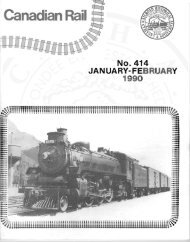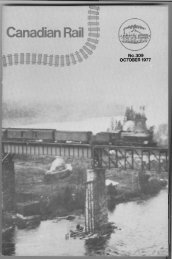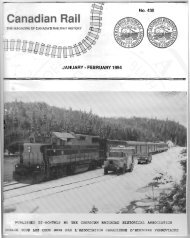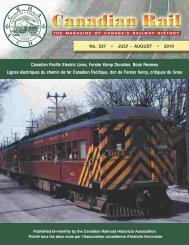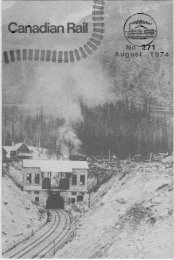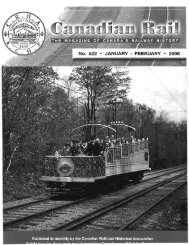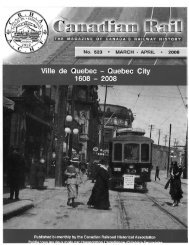Canadian Rail_no200_1968
Canadian Rail_no200_1968
Canadian Rail_no200_1968
Create successful ePaper yourself
Turn your PDF publications into a flip-book with our unique Google optimized e-Paper software.
June 196
Til CII.'llll<br />
A ST. l l.Bllel<br />
BIILI81B<br />
:JrIX:Fl.S wr "Y'~..A. :Fl.S :p<br />
~~FI....A. -rX1V<br />
~HENEVER A NIDN<br />
S. S. Worthen<br />
publication about Canada's early railway<br />
appears, the railway historian lives in the hope<br />
that this time, the author will demolish once and for<br />
all, the many and proliferating myths that seem to<br />
pervade all the histories which have been published hitherto.<br />
But, alas~ This is seldom the case, for the errors<br />
which began with Messrs. Trout in 1870 have been continued<br />
to the present day.<br />
THIS ARTICLE 1<br />
THEREFORE, is written in the tradition of the<br />
late Robert H. Brown, one of Canada's leading railway historians,<br />
in an attempt to clarify the early history of<br />
Canada's first railway, by a restatement of actual reports<br />
from the period, and a consideration of general conditions<br />
in Lower Canada, at that time,which had a great influence on<br />
the day-to-day operation of this unique enterprise.<br />
IN THE EARLY 1830's, the War of 1812 was beginning to fade<br />
in the memory of <strong>Canadian</strong>s, and the United States had re-established<br />
the trading practices which were to build that<br />
country into the foremost mercantile nation of the twentieth<br />
century. The Hudson River - Lake Champlain - Richelieu River<br />
trading artery again began to prosper and it was,with some<br />
irritation that the merchants and traders of Montreal waited<br />
while barge-loads of merchandise described the eastward<br />
r.iver journey via the town of Sorel, and then variously went<br />
down the St. Lawrence to Quebec or turned westward again to<br />
Montreal. The lesson offered by the Mohawk and Hudson <strong>Rail</strong>road<br />
in the neighbouring state of New York, did not go ~nheeded,<br />
and thus, in 1832, the business men of Montreal<br />
chartered a railroad.<br />
BUT LET US stop a moment and consider the "climate" in which<br />
this new venture was to be born. Distrust and unrest in<br />
Great Britain had been partially responsible for the protective<br />
tariff which the United States had imposed on <strong>Canadian</strong><br />
goods. Ship fever had reached epidemic proportions in Montreal<br />
and Qu~bec twice in three years. A wet summer in 1835,<br />
was succeeded by a crop failure in 1836 - the year the in-
CANADIAN 140 R A I L<br />
fant railway was opened. In 1837 "Old Hickory" Andrew<br />
Jackson's monetary policies in the United States resulted in<br />
a panic that closed the banks in Lower Canada for two years.<br />
There had been deaths in the election riots of 1832 and tragedy<br />
rode on a wind of wild political words as the extremist<br />
groups in both the Canadas organized themselves to obtain by<br />
force what they failed to win by democratic means. And, in<br />
this confused, uncertain time, Canada's first railway wasto<br />
be opened.<br />
THE PROJECTED RAILWAY from La Prairie, on the St. Lawrence<br />
River to St. Johns on the Richelieu River has been variously<br />
described as straight and level with no physical obstacles<br />
whicb woUld, in any way, complicate the construction of the<br />
railway and would provide a straight and level line of rails<br />
for the transport of goods and passengers. It ",·as so described<br />
probably in order to allay any apprehension which the<br />
subscribers to the undertaking might ha ve. In reality, it<br />
had only two gradients of any consequence, and these were in<br />
favour of the traffic towards Hontreal. But tbey did cause<br />
some complications. As for curves, there were three. The<br />
gentle curve to the eastward, on the outskirts of St. Johns,<br />
did not delay the trains, but the S-curve in the woods near<br />
L'Acadie did.<br />
THE ROADBED OF the Chamolain & St. Lawrence is still very<br />
evident eVen in <strong>1968</strong>. From the steamboat wharf at the edge<br />
of the St. Lawrence, the right-of-way climbed about 30 feet<br />
to attain the l evel of LaPrairie Common, from whence it ran<br />
straight and level to the ridge of land some 2 miles northwest<br />
of L'Acadie Village. Tbis natural barrier could not be<br />
overcome by direct assault, so the railway took advantage of<br />
a small gulley to climb the ridge. A shelf was excavated on<br />
the side of the gulley and the railway, after turning s outhward<br />
along the hillside, made a second curve to the east,<br />
which brought it to the summit of the ridge. From this point<br />
it took a straight course to the outskirts of St. Johns,<br />
where a very gentle curve to the east was required to align<br />
the right-of-way with the wharf on the Ricbelieu River. The<br />
vertical rise through the woods near L'Acadie can be estimated<br />
at about 35 feet. This "'ould mean a 1.3% gradient - not<br />
much by today's standards, but a real killer for an 0-4-0<br />
running on strap rails~<br />
THE LOCOJviOTIVE ENGINE for the new raib"ay was ordered from<br />
Robert Stephenson and Company, then of Newcastle-upon-Tyne,<br />
England, and wa s booked by them on 26 October, 1835, the<br />
127th locomotive which they had built. It was completed<br />
about 1 t~rch, 1836, and was recorded as costing 1200 pounds<br />
sterling. Its wheel arrangement was 0-4-0, one of the standard<br />
"Samson" type of this firm of builders. The wheels were<br />
48 inches in diameter and of wood. The cylinders were 9"x14"<br />
and the locomotive weighed 112 hundredweight, 0 quarters and<br />
19 lbs. - 12,563 lbs. in working order. It was about 13 feet<br />
long but with a wheel-base of only 5 feet, and, as a result,<br />
the engine was very unsteady and could only run at reduced<br />
speeds - safely, that is~
C. & St. L. "Dorchcst"r'·-Stephenson-lS36.<br />
(FrVlll (l 111"f1\\ill;: h.1 11. H. Iln'\\ll.)<br />
HI'IHOUT A LEADING bogie, the "Dorchester"(for so it 11as subsequently<br />
named) negotiated the rough and uneven track with<br />
difficulty. When pulling loaded cars, there was a tendency<br />
to derail. After the pur chase of tl'/O Horr is 4-2-0 ' s for the<br />
railv!ay in 1837 and 1839, the need for the addition of a<br />
leading truck Has obvious, and the subsequent dato. indicates<br />
that the "Dorchester" was rebu1lt about 1840 to a 4-2-0 type<br />
with the installation of a new and larger boiler and a haystack<br />
firebox.<br />
SOHE 'Inm AFTER her arrival in Cc:nada the ne'" locomotive was<br />
given a name. She Has named "Dorchester" in honour of the<br />
town of that narJe, Hhich later became St. Johns, Quebec . The<br />
tovm '''as named "Dorchester" about 1815, and from that year<br />
to 1835, Has officially the namesake of Lord Dorchester, although<br />
the choice Has not popular.<br />
IN VARIOUS HIST01UES of <strong>Canadian</strong> railways, it is stated that<br />
the ne'." 10comoU.ve Has named "Kitten." This nume ,,,as probably<br />
given the new locomotive because of its r ather erratic<br />
and kittenish behaviour - a reasonable situation when one<br />
considers the inexperience of the supervising "engineer" and<br />
the state of the ra11Hay. Contemporary accounts (27 June,<br />
1836, 19 August 1836, 23 July 1836, 25 July 1836, and 30<br />
July, 1836) do not mention the name "Dorchester" in conn8Ction<br />
';lith the opening day celebrations of the railway, and<br />
some later trips on it and so it is probable that the engine<br />
l·laS not "officially" named until later \-/hen other locomotives<br />
came to run on the line.<br />
THE COi1PANY OF Proprietors' of the Champlain and St. LaHrence<br />
<strong>Rail</strong> Road were anxiously aViaiting the arrival of their new<br />
locomotive in the spring of 1836. At the meeting of the<br />
stockholders on 9 Hay, the President, i1r. Peter :iJcGill reported<br />
that it had not yet arrived but Has expected soon. A<br />
careful search of Customs House records has failed to find<br />
mention of the importation of a steam locomotive.Perhaps the<br />
parts of the "Dorchester" wers included in the entries of<br />
"boilers and machinery," of which there Here several. Presumably<br />
these parts ",ere discharged at the Port of Quebec<br />
and brought to i'iontreal by river lighter.
CANADIAN 142 R A I L<br />
THE ARRIVAL OF the new engine at La Prairie is shrouded in<br />
an air of mystery. Perhaps this cloudy aura was due to one<br />
of two circumstances:<br />
1. The parts of the engine were off-loaded at Montreal<br />
and assembled at an iron foundry under the supervision<br />
of the locomotive engineer who accompanied the<br />
engine from Newcastle;<br />
2. Perhaps the Directors were apprehensive of the<br />
public reaction to the use of such a dangerous "machine."<br />
THE ASSEMBLY OF the locomotive had to be carried out under<br />
the supervision of the accompanying "locomotive engineer"<br />
since there certainly was no one in Canada so qualified at<br />
that time. In fact, tbe defection of this engineer was to<br />
have serious consequences in about a month's time~<br />
TRIALS OF THE "Dorchester" are rumored to have been conducted<br />
after dark, which lends even more spice to the early<br />
history of the engine. One prosaically logical explanation<br />
for this peculiarity was that since the presence of the<br />
Directors was essential to these trials, they were carried<br />
out after the Directors' normal working day.<br />
NOTWITHSTANDING THESE CLANDESTINED goings-on, a young men's<br />
social club called the "Gilchristiana" visited La Prairie on<br />
16 June, 1836 and reported in their minute-book:<br />
"Went and looked at the new locomotive carriage, compact<br />
and elegant, and the fuel car and feeder, well built and<br />
very neat."<br />
It is therefore safe to say that the parts had been assembled<br />
by that date.<br />
WITH THE OPENING of the new line less than two weeks away~<br />
disaster struck~ The Quebec GAZETTE of 13 July, 1836<br />
chronicled tbe mishap:<br />
"An accident has happened to the locomotive for the<br />
railroad. The fireman let the water out of the boiler<br />
and kept the fire going until the flues were burnt. She<br />
will need new ones before she can proceed."<br />
ON THE DAY of the opening, "Dorchester," with half her tubes<br />
plugged, was very feeble indeed. The effects were reported<br />
in the press:<br />
"Before starting, the locomotive engine made two short<br />
trial trips with its tender and, as the accident, which<br />
occurred lately to it had not been thoroughlY repaired,<br />
it was deemed advisable to attach it to only two of the<br />
covered passenger cars while the other cars with the<br />
rest of the company were drawn each by two horses. The<br />
locomotive with its complement soon shot far ahead of<br />
the other cars •••• The locomotive in returning took four<br />
cars with it, and the other twelve were dragged back, as
CANADIAN 143 R A I L<br />
before, to LaPrairie by horses ••• The return trip of the<br />
locomotive on Thursday, was completed in fifty-nine<br />
minutes but we learn that yesterday, with four passenger<br />
cars and two loaded freight cars it effected the journey<br />
in 45 minutes and returned in 30, over a line l4t miles<br />
in length. A few repairs have been made to the engine<br />
and her regular trips commence on Monday next."<br />
THE PRECISE OPENING day was Thursday 21 July, 1836. The<br />
average speed (by calculation) was 14.5 miles per hour. On<br />
Friday, the southbound trip, with a considerable load, was<br />
made at an average of 19.3 m.p.h., while the return run, on<br />
the same day showed an average speed of 29 m.p.h.This latter<br />
figure is somewhat unbelievable and must be due to reportorial<br />
misinformationt<br />
ABOUT A WEEK later (30 July, 1836), the engine was again removed<br />
from service, The locomotive engineer, who had been<br />
sent out to Canada by Robert Stephenson and Company, summarily<br />
departed from the employ of the railroad. Where he<br />
went is not recorded but in any event, it was "awayl" Possibly<br />
his hasty departure was precipitated by the episode of<br />
the burned boiler flues and the somewhat incandescent<br />
tempers of the Company Directors~<br />
BUT THE DISAPPEARANCE of the "qualified" locomotive engineer<br />
placed the Directors squarely in the middle of a dilemma.<br />
Where to obtain another " locomotive engineer," - a courageous<br />
and stalwart man, brave enough to cope with boiler pressures<br />
of the order of bO pounds per square inch, And lol from the<br />
engine-room of one of Mr. Molson's steamboats on the Montreal-Quebec<br />
runt appeared such a stalwart - Ziba Pangborn<br />
by name, a <strong>Canadian</strong> by adoption and a Yankee of the Vermont<br />
school by birth. As Chief Engineer of the Molson steamboat<br />
line, he was accustomed to work<br />
with low pressure marine engines,<br />
and so it was, with surprise and<br />
relief, that the directors heard<br />
his noncommittal reply to the<br />
crucial question: "Can you make<br />
it go?" - "Waal, it's an 'n-gine<br />
aint it?"<br />
The Association's intrepid President,<br />
Dr. R.V.V.Nicholls, also<br />
the first editor of the Association's<br />
BULLETIN, industriously re~<br />
furbishes the marker on the still<br />
existing right of way of the Champlatn<br />
and st. Lawrence <strong>Rail</strong>road.<br />
Erected where the track crossed<br />
Highway 9-A, this association markercommemorates<br />
the celebration of<br />
the one-hundredith anniversary of<br />
the opening of the railway, on<br />
July 21, 1836.<br />
Photo courtesy N. Nicholls
Commemorative monument erected at the former site of the<br />
ferry dock at La Prairie,Que. and dedicated on July 21,<br />
1936,during the celebration of the centenary of the Champlain<br />
and St. Lawrence <strong>Rail</strong>r.oad.MontreaJ.' s modern skyline<br />
is visible in the background.<br />
Photo S.S.Worthen.<br />
AFTER EXAMINING THE MONSTER, Ziba opined that all she needed<br />
was plenty of wood and water to make he~ go. Apparently, he<br />
was right. About a week later the Montreal GAZETTE reported:<br />
"We are glad to learn that the locomotive engine is<br />
in operation on the St. Johns <strong>Rail</strong>road. The new<br />
engineer has given it an examination and made a<br />
trial of its speed yesterday. With four cars<br />
to itl it went to St. Johns in 48 minutes and returned<br />
with five cars in 41. From Montr~al to St.<br />
JOhns, a person may now be conveyed in an hour and<br />
a quarter; a slight change from the old system of<br />
travelling, when some four to six hours of most uncomfortable<br />
joling were by no means unusual."<br />
DURING ~[,HE HEJviAINDER OF THE SUM}lER OF 1836, the railroad operated<br />
in a somewhat restricted fashion. On October 1, 1836, the embargo<br />
on freight, which had been imposed on July 30, as a result of the<br />
burned flues in the "Dorchester," was lifted. Nevertheless, the<br />
engine's operation was not very well understood, despite the fact<br />
that a large amount of freight was transported in October and November,<br />
just before the winter freeze-up. Dur i.ng the winter of<br />
1836-37, from November to April, \"hen both shipping and railroading<br />
were suspended, the engine was taken to the machine shop of<br />
the steamboat line. There the foreman, Ziba Pangborn, took "her"
CANADIAN 145 R A I L<br />
to pieces, examined "her" thoroughly in all of "her" parts and<br />
then completely repaired and reassembled "her." The following<br />
April, when navigation and operation of the railway were resumed,<br />
the 10c0motive was in good running order, and George Pangborn<br />
rapidly became more expert in engine-driving. It is worthwhile<br />
noting that the little "Dor
CANADIAN 146 R A I L<br />
THEHE HERE OTHER Al1ENIT IES , which were stipulated in the original<br />
Charter of 1832 (II George IV Cap. 58). Very elaborate directions<br />
were provided for the construction of overhead bridges and underpass<br />
subways wherever public roads crossed the line. As an afterthought,<br />
it was stated that if such a horrible thing as a level<br />
crossing ' vlas actually necessary, then the crossing would simply<br />
have to be protected by double swing gates~ according to the design<br />
which afterwards became so popular in ~ngland. These gates<br />
were to be placed so that they would be slJlUng across the raih.,ay<br />
line at all times except when a train was actually passing.<br />
Naturally, it turned out that all of the road crossing were level<br />
crossings and even the provision of swinging gates, did not prevent<br />
the occurrence of Canada's first level crossing accident.<br />
The Montreal TRANSCRIPT reported, in the summer of 1837, that the<br />
train had bumped into a team of oxen at the Cote St. Raphael<br />
crossing. The newspaper did not relate the nature or extent of<br />
the damage to the ox team, but the train "",as thrown off the<br />
track."<br />
THE CHIEF ENGINEER, Mr. Casey, had provided for the construction<br />
of two "turn-outs" or passing sidings on the line - one at Cote<br />
de la Bataille, the other at Little River (L'Acadie). More were<br />
to be added, "as experience shows where they will be most convenient."<br />
However, the principal obstacle continued to be troublesome<br />
grade . and reverse curve just east of Cote de la Bataille.<br />
Mr. George Washington Johnson of Clarenceville, Que., in his memoirs,<br />
"My Part in the Defense of the Frontier District During the<br />
Papineau Rebellion of 1837," has the following comment:<br />
"The raih.ray, which then ran between St. Johns and<br />
Laprairie, and by which I travelled, was the first<br />
in Canada and a very primitive affair. When we<br />
came to a steep grade, all the passengers had to<br />
get out, and those of us, who were men, had to put<br />
our shoulders to the cars and help them up the<br />
hill."<br />
The February, 1837, issue of the Cowansville, Que., OBSERVER,<br />
ran an advertisement as follows:<br />
"A stage coach will operate from St .Johns to Stanbridge,<br />
Frelighsburg, Richford, Sutton and Potton,<br />
Canada East, to Troy] Vermont, three times weekly,<br />
departing from St. ohns on the arrival of the<br />
train on the Champlain and St. Lawrence <strong>Rail</strong>way.<br />
In the winter, passengers will take the St. Johns<br />
and Montreal stage."<br />
DESPITE THE UNPLEASANTNESS caused in 1837, by the Honorable<br />
Louis Joseph Papineau, (who had been one of the prominent<br />
figures on opening day) and others, operation in this year<br />
proved to be moderately successful. During this year, the<br />
first movement of military personnel over a <strong>Canadian</strong> railway<br />
was recorded, as the militia entrained at Laprairie to<br />
confront the Patriots south of St~ Johns. Mason Wade says<br />
that by way of retaliation, the Patriots tore up one or two<br />
miles of the line, between St. Johns and L'Acadie. Notwithstanding<br />
these transient, but heart-breaking interruptions,<br />
the railway did turn in a good balance sheet in 1838-39, as
The crossing of the Ruisseau des Barbots, near Cote St-Raphael. The<br />
embankment, about four feet higher than the normal ground level at<br />
this point. now began to rise slowly to gain the plateau between<br />
Cote de la Bataille and Little River (L'Acadie). S.S.Worthen photo.<br />
the following table will show:<br />
Traffic Net Dividends Rate.<br />
Year ReceiDts {sterling~ Profit Der share<br />
1836 6042 1986<br />
1837 10177 2665 6-09-00 13.5%<br />
1838 9799 2522 -<br />
l8a9 15496 8188 12-10-00 25.0%<br />
18 0<br />
la 339 5107 ~-1O-00 15.0%<br />
1841 1 000 5242 -00-00 16.0%<br />
THE EXTRAORDINARY INCREASE in receipts (and dividends) of<br />
1839, was probably not due to improved conditions in the<br />
country, since there was still a general condition of economic<br />
depression. More likely, it was the result of the<br />
purchase of two new Norris engines, - the "Laprairie" and<br />
the "Jason C. Pierce," built in 1837 and 1839 respectively.<br />
The railroad was consequently able to handle a much larger<br />
volume of traffic.<br />
THE LOWER CANADA Almanac and Montreal Commercial Directory<br />
for 1840 contained a complete set of passenger and freight<br />
rates, and the rules and regulations regarding the sale of<br />
tickets and the conduct of passengers. All seats in the passenger<br />
cars were reserved. One hundred and thirty-five items<br />
were listed in the freight tarriff, and the rate for the 14t<br />
miles for all articles not enumerated was about 17 cents per<br />
ton mile - not bad for 1840! The passenger rates were:<br />
FIRST CLASS (with not more than 30 pounds of baggage)
CANADIAN 148 R A I L<br />
<strong>Rail</strong>road & Ferry - 5 shillings Halifax currency<br />
<strong>Rail</strong>road only - 4 shillings Halifax currency<br />
Ferry only - 7t pence .<br />
Same Day over and back - 7 shillings 6 pence<br />
SECOND CLASS -<br />
<strong>Rail</strong>road & Ferry - 2 shillings 6 pence<br />
<strong>Rail</strong>road only - 2 shillings<br />
Children under twelve years of age - half price.<br />
PASSENGERS HAD TO purchase their tickets on the steam ferryboat,<br />
and to occupy the place in the car indicated by the<br />
ticket. Tbey had to state their return intentions on the<br />
ferry and - if desired - take a return ticket at the reduced<br />
rate. Otherwise they would be charged full fare both ways -<br />
a very reasonable and enduring procedure. No one was allowed<br />
to ride on the engine, except the engineer and fireman, unless<br />
they were willing to pay 10 shillings the fine for<br />
each offense. Likewise, smoking in the First Class cars was<br />
forbidden a further 10 shillings ($1.96) being required<br />
for infractions. It was more expensive to ride on top of the<br />
cars at the rate of 25 s. ($4.89) per apprehension. Dogs<br />
were excluded from the first-class cars at the rate of 20 s.<br />
($3.912) per time.<br />
'I'HERE ARE, OF course, some momentos of Canada's first railroad<br />
still on exhibition. In 110ntreal's_Chateau de Ramesay,<br />
(to be precise, in the cellar of this historic building) is<br />
a very accurate wooden representation of the "Dorchester."<br />
It can be examined ~lhenever the Cha teau is open to the<br />
public. Probably less well-known is the "lOoden model in the<br />
Hanoir Lachine, Lachine, Que., which is also of wood J equally<br />
dilapidated, and less accurate, inasmuch as it lacks cranks,<br />
side rods and other details. However, it has the distinction<br />
of being the model used in the celebrations of the 100th<br />
Anniversary of Canada's <strong>Rail</strong>ways which unfolded on the weekend<br />
of 21, July, 1936. It was drawn behind <strong>Canadian</strong> National<br />
Raihrays 4-8-4 No. 6400, to St. Lambert, and thence, to St.<br />
Johns, part of the way over the same historic right-of-~,ay<br />
which had borne its ancestor for 14t miles a century before.<br />
IN FACT THE right-of-way itself is still plainly visible today,<br />
and may be seen (and photographed) about a quarter of a<br />
mile south of High.l8Y No.7 (La Prairie to St. Johns) on (a)<br />
Highway No. 9A, where the Association has a commemorative<br />
marker, (b) Cote St. Raphael, where the original railroad<br />
bridged the little Riviere des Barbots and continued east on<br />
a high embankment and (c) Cote de la Bataille (south) \·,here<br />
the railroad came across the flat plain on a four m six foot<br />
emban~nent, preparatory to climbing the hill to Little River<br />
(L'Acadie River or Petite Riviere Montreal) bridge and the<br />
town of Little River - now L'Acadie. Then, if you don't mind<br />
a short hike walk along the derelict right-of-way from Highway<br />
No. 9A to the crossing of the Riviere St-Lambert and you<br />
won't have any difficulty in identifying the place where<br />
the bridge used to be. If you are not so athletically inclined,<br />
then you can always try to discover the three com-
One hundred and thirty two years later, the road-bed<br />
of Canada's first public railway runs straight as a<br />
die eastward from Cote st - Raphael to Cote de la<br />
Bataille and the ridge at Little River dimly visible<br />
on the horizon.<br />
The present day right-of-way of the C. & S.L. running<br />
east from Highway 9-A, about three miles from<br />
the river front at La Prairie, Que. Just beyond the<br />
growth of bush, the railway crossed the st. Lambert<br />
River.<br />
Both photos S.S.Worthen
CANADIAN 150 R A I L<br />
memorative plaques (one of which has the wrong dates on it)<br />
at St. Lambert-La Prairie and St. Jean d' Iberv1l1e. Canada's<br />
first railway has by no means entirely disappeared, although<br />
the history text books in today's elementary schools would<br />
certainly give one that impression~<br />
THE AUTHOR is particularly indebted to the late Robp.rt R.<br />
Brown, who personally researched much of this material but<br />
who, in addition, first discovered to the author the true<br />
joys of historical research on Canada's railways, par-<br />
ticularly in the region of Montreal.<br />
Sources:<br />
The Champlain & St. Lawrence <strong>Rail</strong>road -<br />
Robert R. Brown<br />
Bulletin No. 39, <strong>Rail</strong>way<br />
& Locomotive Historical<br />
Society, Boston, 1936<br />
Montreal TRANSCRIPT<br />
Cowansville OBSERVER<br />
The French <strong>Canadian</strong>s<br />
1836-37<br />
1837<br />
Mason Wade<br />
Macmillan 1955.<br />
INSIDE FRONT COVER I The wooden replica of the "DORCHESTER",<br />
constructed by Messrs. Cole, O'Dowd, Renaud and others, from plans<br />
prepared by Messrs. John Loye and Robert R.Brown, a t the Chateau<br />
de Ra mesay, Montreal, in the months before the <strong>Rail</strong>wa y Centennial<br />
Celebration in July, 1936.<br />
Photo W.G.Cole Collection.<br />
OUR COVER THIS MONTH is artist J.D.Kelly's impression of the opening<br />
day celebrations a t some point on Canada's first public railway<br />
The Cha mplain & st. Lawrence <strong>Rail</strong>road. Although some liberties have<br />
been taken with the locale, the portrayl of the 'Dorchester' and<br />
the two first-class pa ssenger cars is quite accura te. This colour<br />
reproduction is made ava ilable through the courtesy of the Confederation<br />
Life Assurance Co mpany, and the Southam Printing Company.
66 CAN AJDXAN RAIJL??<br />
200 KSSUES OF<br />
PROGRESS<br />
F.F.Angua<br />
"DIESELS FOR THE NAPIERVILLE JUNCTION RAILWAY"<br />
"TROLLEY BUSSES TAKE OVER PASSENGER SERVICE IN<br />
CORNWALL"<br />
" 'TRAIN OF TOMORROW' IN CANADA"<br />
SO READ THE HEADINGS of the first issue of the<br />
C.R.H.A.'s "News Report" one day in October,1949. This small<br />
4-page report was the first in a series which,in the ensuing<br />
two decades,has changed and grown into CANADIAN RAIL, which<br />
this month publishes its two-hundredth issue.<br />
OUR ASSOCIATION,IN 1949, differed greatly from<br />
what it is today. Although 17 years old, its membership had<br />
declined to suoh an extent during the war years, that only a<br />
few dedioated persons prevented its oomplete disappearance.<br />
However, its basic aims were the same,and the turning point<br />
came in 1947,when the centennial celebrations of the Montreal<br />
and Lachine <strong>Rail</strong>way reawakened more general interest<br />
in railway history in Montreal. Two years later, the Assoc -<br />
iation's First ohartered tramway and railway excursions attracted<br />
new members and further spread the interest.<br />
THE C.R.H.A.'S FIRST EFFORTS in the publication<br />
field had begun in 1936,when the Association was only four<br />
years old. At this time,Bulletins were produced on <strong>Canadian</strong><br />
railway history and development,with our present President ,<br />
Dr. R.V.V.Nicholls,as Editor. These bulletins foreshadowed a<br />
challanging future and the genesis of CANADIAN RAIL. After<br />
fifteen issues, the series came to a temporary pause,in 1940,<br />
in the second year of World War II,and today,surviving issues<br />
are rare and eagerly sought.<br />
BY 1949,the revitalized C.R.H.A. was once more<br />
in need of a means of regular communication with the membershlp,and<br />
the News Report was firs~ produced in October 1949,<br />
under Editor E.Allan Toohey and publisher R.J.Joedicke. The<br />
early issued were mimeographed sheets,printed on one side ,<br />
and were written,printed,assembled and mailed by about four<br />
vomunteers.The Association found it difficult to pay the invoice<br />
for the postage! The <strong>1968</strong> successors of this first enthusiastic<br />
group still prepare and mail our magazine,although<br />
printing and collating is now done commercially. Circulation<br />
in those days was less than lOO,but nevertheless the<br />
news items and historical articles were of great interest<br />
and are still read and referred to today.
CANADIAN<br />
1.52<br />
R A I L<br />
THE NEWS REPORT was published monthly until August,1951,and<br />
was then suspended till January,1952.Reorganized<br />
under the editorship of O.S.Lavallee,who held the post of<br />
editor for eleven years,it resumed publication of eleven issues<br />
per year,and has continued ever since to be produced by<br />
members of the Association on a completely voluntary basis.<br />
GRADUALLY, THE NUMBER OF PAGES and the circul -<br />
ation increased,and the quality of reproduction was impro -<br />
ved. An important milestone was passed in JulY,1957, when<br />
issue number 80 became the first to carry a photograph. On<br />
the cover was Montreal street car number 274,the Association's<br />
first piece of rolling stock and the inception of<br />
its present-day museum collection. Soon,photo covers were a<br />
semi-regular feature,supplemented from time to time by in -<br />
terior pages of photographs. In May 1959,the one-hundredth<br />
issue was published. It reported,among other items, the recent<br />
demise of street cars in Ottawa,and issue 115 of October,1960,had<br />
pages printed on both sides for the first<br />
time.<br />
UNTIL THE END OF 1960,the News Report had been<br />
printed on large-size pages,but in January 1961,report no.<br />
118 was a completely new departure. Under the direction of<br />
D.R.Henderson,the format of the magazine was changed to the<br />
present size,while the number of pages increased, resulting<br />
in a more compact magazine. In July 1962,the name of our~designed<br />
pUblication was changed to CANADIAN RAIL and about<br />
this time, the circulation passed the 1000 mark. This<br />
figure has continued to climb,and as we reach our 200th.<br />
milestone,about 1500 members now receive CANADIAN RAIL,-ll<br />
times a yearl<br />
During the past 18 years, the pUblication has<br />
chronicled many historical events,as well as happenings that<br />
were then contemporary,but are now history also.In 1949, the<br />
steam engine was King on Canada's railways and electric street<br />
railways still dominated the transit scene in several<br />
cities across Canada. The news items of the period reflected<br />
the great change in railway operation in the post-war years<br />
as dieselization progressed at an ever-increasing tempo. When<br />
one considers that 1949 was the year in which the first diesel<br />
locomotive pulled a train into Montreal's Windsor Station,the<br />
year before <strong>Canadian</strong> National placed the first <strong>Canadian</strong>-built<br />
diesel "A" unit in service,and the year in which<br />
construction began on Canada's first subway in Toronto, one<br />
realizes the effect of less than twenty years,on <strong>Canadian</strong><br />
rail transportation.<br />
IN 1949,A RAIL ENTHUSIAST in the Montreal area<br />
could ride trains from Bonaventure and Place Viger Stations,<br />
as well as Central and Windsor. Most trains were steam-hauled<br />
and suburban commuter services on both railways used gaslit,wooden<br />
cars that dated back to the early years of the<br />
century. One could travel,in a day's outing, over branch lines<br />
which now have no passenger service,if indeed they exist<br />
at all. Those interested in electrio lines could ride the<br />
Montr~al and Southern Counties <strong>Rail</strong>way to Granby,and tour<br />
Montreal's streetcar system which then operated more than<br />
200 miles of track with 1000 cars,more than 400 of which predated<br />
World War I. Stainless steel eqUipment and the Budd Co.<br />
RDC's had not yet appeared in Canada. Montreal's subway was
Assembly Session-old methodl Messrs.Peter Murphy,Tony Clegg<br />
and Paul McGee collate and staple manually an issue of the<br />
NEWS REPORT in John Saunder's dining room.<br />
Photograph courtesy F.F.Angus.<br />
a much-discussed but far-distant fact and innovations, like<br />
the TURBO-TRAIN,were not even in the dream-state. The CRHA<br />
had not yet begun its collection of museum exhibits and although<br />
the vision of a museum was just forming,no one could<br />
forsee that by <strong>1968</strong>,the still-growing collection would number<br />
nearly 100 items.<br />
THE NEWS REPORT and CANADIAN RAIL have reported<br />
the coming of the new and the passing of the old, down through<br />
the years,and have alsO produced,in a permanent form, a<br />
spectrum of historical accounts of the earlier days of railroading<br />
in Canada and elsewhere. It is the aim of the Association<br />
and the producers of CANADIAN RAIL to continue this<br />
so the next 200 issues will be as varied and interesting as<br />
the last have been. The members can help realize this hope<br />
since their contributions of historical and news items has<br />
been and will continue to be a great factor in the success<br />
of the pUblication. The next twenty years will likely see as<br />
much change in the railways of Canada as the last twenty and<br />
it is hoped that CANADIAN RAIL will be on hand to record all<br />
these developments as it has in the past,so that the members<br />
who will produce the 400th. issue will be able to look back<br />
on an equally good "200 issues of progress ll •<br />
..........................................................................................................................................................................<br />
·t ~l.'.T~OI .:.<br />
: ............................................................................ ~.<br />
~. ~.<br />
y ~<br />
.:. THE STAFF OF IICANADIAN RAIL II are proud to pre- .:•<br />
•:. sent to the Membership this 200th. number of our magazine. .i.<br />
·t Despite some temporary episodes of difficulty and delay,its .:<br />
•<br />
•:. production has been steadfastly continued. .:.<br />
+t THE NUMEROUS CONTRIBliTIONS to its pages by our ':.<br />
~+ members and friends are gratefully acknowledged. It has been ~.<br />
~+ said,and should be now reiterated,that without these contri- +t<br />
~. butions,the excellent variety which has characterized this ~.<br />
+.. publication could not be maintained. +:.<br />
·i· SUSTAINED BY THE GOOD WISHES and encouragement +:+<br />
~+ of our many friends and well-wishers and tempered by the nec- ~.<br />
+:+ essary constructive criticism of our mentors, we look forward ·t<br />
~+ with confidence and enthusiasm to a still more useful and pr- ~+<br />
.:+ osperous career for IICANADIAN RAIL" in the months ahead. .:•<br />
:. The Edi tor & Staff. + ••<br />
•:+ .+•<br />
•.. ~ ................................................................................................................................................................... ,T.. %.<br />
.~.~.
This month we present a cross-section of <strong>Canadian</strong> Diesel Locomotives.<br />
CP 70)1, an S-2, is shown on CN rails at Hawthorne, Ontario, backing<br />
into the Piggyback terminal. 21/02/68. (W.R. Linley photo).<br />
, ".
eN 7937 is an NW2. It is shown in Edmonton, Alberta on 13/05/67.<br />
(Photo by B.A. Loat - negative collection of W.B. Linley).<br />
CP 8401 was caught at North Troy at 09:30 on 13/04/68 on the Newport<br />
to Riohford way freight. It is an RS-2. (G.D. Southwood photo).<br />
CN 4114 appeared on an extra eastbound express train on 21/10/67<br />
about 14:10. The unit is a GP9 and is shown at Beaurepa1re, P.Q.<br />
(G.D. Southwood photo).
The famous Tra1nmaster man1fests 1tself 1n CP 8907 shown here at<br />
Reg1na on 01/08/66. (Photo by R.A. Loat - negat1ve collect1on of<br />
Bruce Chapman).<br />
FP9A CN 6537 headed Tra1n 34 , the By towner, on 15/10/67 at<br />
Beaurepa1re, P.~. (G.D. Southwood photo).
O.M. sD4o's are here at Yoho, B.C. on 03/09/67. The tra1n 1s<br />
CP 902 and the un1ts are 5505:5509:5508. (Photo by B.A. Loat -<br />
negat1ve collect10n of W.B. L1nley).<br />
CN 3224:3212 are C-424's on Tra1n 19, the Cabot, Just leav1ng<br />
Drummondv1lle, P.Q.~ on 04/07/67. (W.E. L1nley photo).
EY<br />
F.A. KEMP<br />
-x- hings these days seem to come<br />
in "packages" of various shapes<br />
and sizes. The most recent<br />
member of the "containerized<br />
crew" has been produced<br />
for a very speoialized purpose.<br />
IN APRIL,<strong>1968</strong>,CANADA'S FIRST 40-foot refrigerated container units were placed<br />
in service by <strong>Canadian</strong> National <strong>Rail</strong>ways. Designed for service between Port<br />
aux Basques and St. John's,Newfoundland,the units were primarily experimental<br />
and if proposed tests were satisfactory, subsequent extensive changes in traffic<br />
handling were proposed. The purpose of these containers is to transport a<br />
veriety of dairy products and frozen foods,and other commodities requiring<br />
special temperatures during shipment. CN's present container fleet numbers<br />
1,100 units,- 20 feet long and non-refrigerated. 'The new units,- 40 x 8 x 8<br />
feet~are refrigerated and can maintain interior temperatures between -10 and<br />
+ 60 F. They are completely self-sufficient for power,being equipped with a<br />
diesel generator,eutomatic controls and large fuel tanks. Three of the new<br />
units were for use in "captive" service, replacing refrigerator cars between<br />
the two termini of CN's ieland operation. The fourth unit was put in through<br />
service between Newfoundland,Montreal and Toronto. The four new units were<br />
built to ride on specially-designed flet cers,rebuilt in CN's Moncton Shops<br />
from general service flets. The new cars and containers permit semi-sutomatic<br />
transfer between rail and road vehicles,or may be handled by cranes.<br />
MONTREAL LOCOMOTIVE WORKS LIMITED, in a notice given to<br />
its stockholders, has announced that its name will be changed to MLW-Worthington<br />
Limited,if the recommended change is approved at the Company's next<br />
annual meeting. MLW is presently one of three companies building dieselelectric<br />
locomotives in Canada, but this company's business has been developing<br />
increasingly in areas other than rail transportation. MLuJ was founded as the<br />
Locomotive and Machine Company of Montreal, in 1905,as a subsidiary of the American<br />
Locomotive Company,- the name being chenged to the Montreal Locomotive<br />
Works several years later. Originally, it was a wholly-owned subsidiery of A.<br />
L.Co.,which later retained a controlling interest,until recent years. When<br />
production of railway locomotives changed from steam to diesel in the 1950's,<br />
other contracts were obtained for the fabrication of pressure vessels end<br />
heat exchangers,which started the diversification that has continued to the<br />
present time, A similar change in the psrent company's activity was reflected<br />
in ths change of name to ALCO Products Inc.,and its acquisition by the Worthington<br />
Corporation. This latter company also obtained control of MLW and~ in<br />
1967,the subsidiary Wortheington Canada Limited was merged with MLW. The<br />
Worthington Csnada plant,in Brantford,Ont.,makes a variety of pumps,feedwater<br />
heaters and heat exchangers, as well as sllied equipment. Some readers may re-
CANADIAN 159 R A I L<br />
member that Worthington equipment was used on steam locomotives,built fer the<br />
<strong>Canadian</strong> Pacific <strong>Rail</strong>way,in the 1940's. The Worthington Corporation OWIIS 52%<br />
of the MLW stock.<br />
CANADIAN PACIFIC RAILWAY'S ADVANCE schedule circular, issued<br />
5 April <strong>1968</strong>,effective 28 April,shows all schedules in local time, merking<br />
the first occasion on which this has been done on a summer schedule, except<br />
during war-time. Trains 417-418 will operate between Sudbury and White<br />
River,Ont.,axcapt Monday,and Trains 236 (Ottawa-Montreal:Sunday) and 295-298<br />
(Montreal-Vaudreuil ) will return this summer, apparently to serve Mayor Drapeau's<br />
"Man and His World".<br />
CANADIAN NATIONAL RAILWAYS has announced that the paaaenger<br />
train service between Deux Mont agnes and Pointe Calumet,Que., will be<br />
discontinued. This service, operated in the summer season only as an extension<br />
of the Montreal-Deux Montagnes suburban service, provided transportation to &<br />
from the cottage colonies of Pine Beach and Roger Beach,in addition to Pointe<br />
Calumet. The 4.3-mile branch line is known as the Oka Subdivision of CN, although<br />
it did not reach the village of Oka. Freight business on the line has<br />
been negligible recently, being limited to traffic from a couple of sand pits<br />
and a warehouse. Passenger service has usually consisted of three or four trains<br />
Monday to Friday,five on Saturday and three on Sunday. Most of these are<br />
"shuttles",connecting at Deux Mont agnes with normal trains, but through trains<br />
have been run on Satur~ays and Sundays,and often at least one on other days.<br />
Diesel-electric engines have been used on the line since their introduction<br />
to suburban ssrvice,but oil-electric cars and X-iDa class 4-6-4 steam engines<br />
were also used during the 1950's. The writer can remember seeing all three<br />
forms of power in service on the same day,when the steam engine was temporarily<br />
relieved by a 7900-class diesel-electric switcher. The period of summer<br />
operation has been shortened in recent years. It formerly extended from May<br />
24 (Victoria Day) to mid-October (Thanksgiving Day),but more recently it has<br />
been revised to coincide with the public school vacation period from the third<br />
week in June,to Labour Day. Paseenger service patronage has been affected<br />
by the opening of a connection to the Autoroute des LaurentidBS and by the declining<br />
popularity of the area as a summer resort,as well as all-year occupancy<br />
of cottages,with local residents taking the train at Deux Montagnes(formerly<br />
called St. Eustache-sur-le-Lac).
THE<br />
66 SNOW 99<br />
EXCURSION<br />
On Saturday, March 2, a bright, sunny Winter<br />
morning which followed two days of mild weather, a group of<br />
Association members, gathered in the <strong>Canadian</strong> Paciflc <strong>Rail</strong>way's<br />
Windsor Station, at the end of a track on which two<br />
RDC units, 9105 and 9065, waited to receive them. The "A 11<br />
Aboard" was called and the train left on time at 8 :45 A.M.<br />
After brief stops for passengers at Westmount-Montreal West<br />
and LaSalle, the train rumbled over the chilly St. Lawrence<br />
River and the frozen Seaway canal, then sped over the snowy<br />
field to St. Johns. Another pause to take up more excursionists'<br />
then on to Farnham, where we stopped several minutes<br />
to obtain a clearance and orders for our passage over<br />
the Ne\.port Subdivision from Brookport to Newport, Vermont.<br />
The first photo stop of the day was made at<br />
this diminutive train-order office which stands between the<br />
Sherbrooke and Newport Subdivisions, from which its name is<br />
derived. The flagman was let off about one mile West of the<br />
junction point; the passengers at the station, where they<br />
staked out their positions while the train backed up, retrieved<br />
the flagman, then advanced, at medium speed through<br />
the junction and swept past the waiting cameras and microphones<br />
with clattering wheels and swirling snow.<br />
The Newport Subdivision is a winding track<br />
that follo\fs the valleys of rivers and streams between rolling<br />
hills which soon become high enough to be called mountains,<br />
- although Westerners would not so call them. The<br />
towns and villages are some',.hat like those of adjacent Vermont.<br />
We passed through Cowansville at speed, its red-brick<br />
station enveloped in wind-blown snow. The station is one of<br />
the last vestiges of the South Eastern <strong>Rail</strong>way's ownership<br />
of the line.<br />
Mileage 9, the site of the former Sweetsburg<br />
station, was the location of our next photo run, around a<br />
curve and over the crossing of Highway 13.The track at this<br />
point is on the opposite side of the valley from Sweetsburg<br />
village. Some of the few motorists on the snowy road, seeing<br />
the people along the track, stopped to ask what was going<br />
on.<br />
The site,of another former station, that of<br />
Enlaugra - (originally Sutton Junction) - provided our next<br />
stop. Only the abandoned one-stall enginehouse remains<br />
where the Drummondville Subdivision once connected, but a<br />
tiny village is still clustered around the road crossing.<br />
The same road, \.hich leads to Brome provided a good vantage<br />
point for the photographers.
CANADIAN 161 R A I L<br />
The next two important towns, Sutton, Quebec<br />
and Richfort, Vermont were passed without stopping althougb<br />
the man in the Canada Customs office at the former station,<br />
took a second look~ At Richford we followed the Mississquoi<br />
River Valley which takes little heed of man-made boundaries<br />
as the river finds the easiest course between the Sutton<br />
Mountains of Quebec and the Green Mountains of Vermont, and<br />
the railway follows, crossing the U.S. - Canada line three<br />
times in a few miles. The climb up to the height-of-land<br />
between the Mississquoi and Mempbremagog valleys brought<br />
memories to some of us of double and triple-headed freight<br />
trains, with towering columns of smoke riSing to proclaim<br />
their conquest of Newport Hill. Even the 1200 horsepower of<br />
our four underslung Diesels were fully required to urge the<br />
two cars up to tbe top where the white expanse of Lake Memphremagog<br />
was spread before us - the only level surface in<br />
this hilly country. A steep descent soon brought us literally<br />
down to lake level, for the last half-mile is laid on<br />
a rock fill in the lake.<br />
We were rather surprised to see that the<br />
station bad been demolished, in fact J<br />
the only remaining<br />
section of platform is on the Clyde River trestle on the<br />
QCR line. To reach this, a reverse move was necessary,<br />
crossing the main street twice. United States Customs and<br />
Immigration officers then boarded the train and performed<br />
their inspection before anyone was allowed to detrain.<br />
Tbe restaurants of Newport were the next objective<br />
of most of the passengers during the remaining 50<br />
minutes of our stop but the majority were back on the train<br />
in good time. A Quebec Central <strong>Rail</strong>way crew took charge of<br />
the train for the run to Sherbrooke, and we were pleased to<br />
see that they still had their Q.C.R. caps although all passenger<br />
service on the railway ended in 1967.<br />
The Beebe Subdivision of the Quebec Central<br />
<strong>Rail</strong>way, from Newport to Lennoxville, was built by the Connecticut<br />
& Passumpsic Rivers <strong>Rail</strong>road. The <strong>Canadian</strong> part<br />
was chartered as the Massawippi Valley <strong>Rail</strong>way and opened<br />
in 1870. It passed to the Boston & Maine <strong>Rail</strong>road in 1887<br />
and to the Quebec Central in 1926. Passenger train service<br />
was discontinued in 1952. The line leaves Newport on a<br />
short, steep grade, passes two long sheds, designated "<strong>Canadian</strong><br />
Pacific Flour Sheds Nos. 1 & 2," then keeps to a<br />
fairly straight course veering away from Lake Memphremagog,<br />
througb rising brushland to the International Boundary, the<br />
wheels clattering almost. immediately over the switches of<br />
Beebe Junction, where the Stanstead Subdivision diverges to<br />
the border straddling freight shed of Rock Island and Derby<br />
Line.<br />
Beebe Junction station houses a Canada Customs<br />
office and the train received a brief inspection before<br />
continuin~ through the snowdrifts which give a peculiar<br />
"floating' motion to RDC units when bitting them. The<br />
way freight, which had made a round trip that morning, had<br />
been delayed two hours on the way, but our passage would<br />
have been impossible had it not gone through.
The Association's SNOW Train - <strong>Canadian</strong> Pacific's RDC 2<br />
no. 9105 and RDC l,no. 9065,pictured at the site of the<br />
former station at Sweetsburg,Que. Photo by W. Bedbrook.<br />
MR. REGINALD HATCH,of Tomifobia,Que.,-retired QCR section<br />
man, standing in the cleared space in front of the monument<br />
whioh he had shovelled out for the Association's SNOW Trjp.<br />
/
CANADIAN R A I L<br />
From Beebe Junction, the line follows the<br />
Tomifobia River on its winding course to Lake Massawippi,<br />
which gives its name to the original railway. A short distance<br />
north of the tiny village of Tomifobia, stands a unique<br />
trackside monument, which is formed partially from a<br />
boulder which fell from a nearby rock ledge and derailed B.<br />
& M. Engine 427 in 1895. The engineer and fireman were<br />
taken to hospital in Newport by the hastily-commandeered<br />
Stanstead branch train, but died of their injuries, and the<br />
monument was later erected about 500 feet south of the actual<br />
derailment site by the two Brotherhoods of Locomotive<br />
Firemen and of Locomotive Engineers. The stones were dug<br />
out for us by Mr. Reginald Hatch, retired QCR sectionman,<br />
who now lives in Tomifobia. This was a still photo stop,<br />
as was the one at Ayer's Cliff station. The first photo<br />
run Was made at the gate of the estate called "Fern Cliff"<br />
near the site of Massawippi Station. Others were made over<br />
the trestle at the outflow of Lake Massawippi in North Hatley;<br />
over the bighway crossing at the site of Eustis Station,<br />
where the background included a covered road bridge,<br />
and around the bend of the river at Adams siding in Lennoxville.Another<br />
still stop was made at the CN station in Lennoxville,<br />
which has lost its Agent and also displayed notices<br />
of a proposed service reduction to take effect at the<br />
end of April. The C.P.R. and B. & M. used CN (G.T.R.) track<br />
to Sherbrooke, but the Q.C.R. uses it for only 0.3 mile to<br />
the mechanical interlocking tower which controls the C.N.R.<br />
C.P.R. connection, where our train switched to C.P.R. track<br />
for the run to Sherbrooke.<br />
Half-an-hour was allowed for servicing the<br />
train at Sherbrooke, while some of the passengers adjourned<br />
to nearby restaurants. A light snow was falling as we left<br />
Sherbrooke in the fading light of late afternoon. About 15<br />
minutes were spent in meeting freight train No. 908 at Rock<br />
Forest, then we made a fast run to Magog, around the end of<br />
Lake Memphremagog, whose frozen expanse we were seeing for<br />
the second time, then up the hill to Mount Orford Station,<br />
which lies beneath the rocky cliffs of the mountain itself.<br />
The fill and viaduct at Eastray which passes above the<br />
village of Eastman, provided the site for our last stop and<br />
photo run, which some people facetiously called a "nightpast,"<br />
due to the lack of available light. Howeveri several<br />
of the parti~ipants took the trouble to get we 1 bogged<br />
down in the snow in order to take advantage of wbat light<br />
remained.<br />
After this, there were stops at Farnham, St.<br />
Johns, LaSalle, Montreal West and Westmount to detrain passengers,<br />
and we arrived at Montreal Windsor Station on time<br />
at 7.30 P.M •• after a very enjoyable day.
" ••• it'8 not 50c a ride, madam .•. and it's the PGE, not the PNE."


